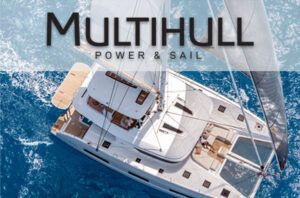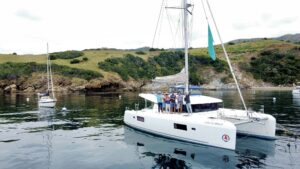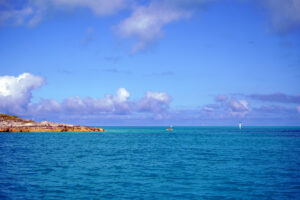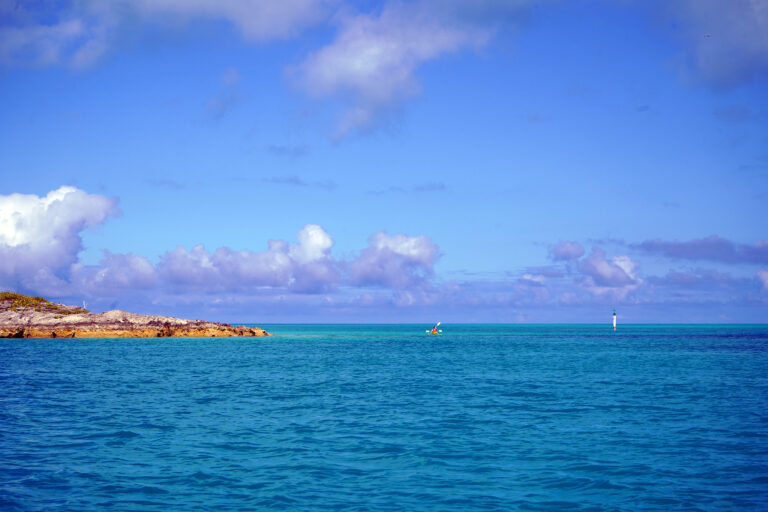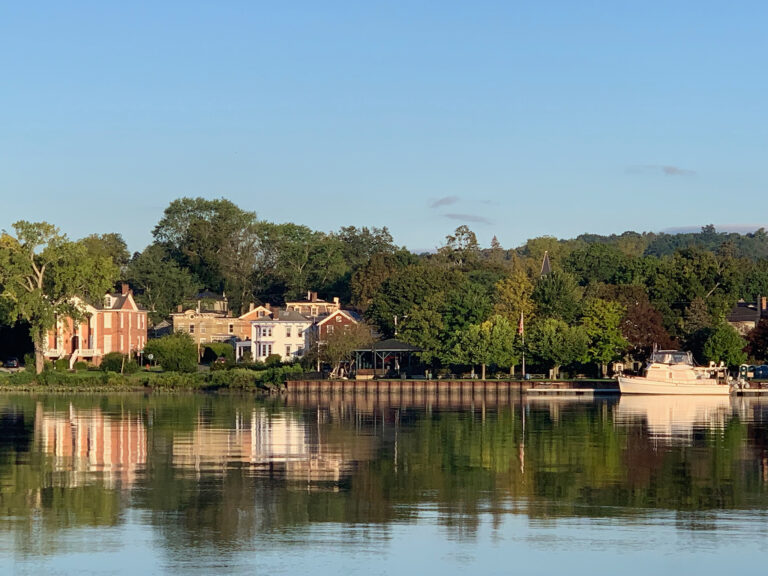The French love affair with multihulls proved contagious at the 5th edition of the Salon International Du Multicoques at La Grande-Motte. This popular Mediterranean resort and port, built during the 1960s and ’70s, has been described by architects as Frank Lloyd Wright meets the Aztecs and Monsieur Hulot on designer drugs. Against a backdrop of sun-bleached pyramid-style apartment blocks, this unique, intimate boat show attracts multihull aficionados from all over the world.
As the only show dedicated solely to multihulls, it offers a great opportunity to see well-known brands—like Lagoon, Leopard, Nautitech, Fountaine-Pajot, Catana, Corsair, Privilege and Outremer—plus many fascinating lesser-known draft dodgers, like Swiss Catamarans Concept and cutting-edge carbon flying machines, like the Raw 30 trimaran, the Pulsar 60 tri and a quirky French aluminum cruising tri, the C329.
The show’s mix of boats on pontoons and artists’ impressions and models of new boats currently in build highlighted the growth of semi-custom hi-tech big cats. Alongside glimpses of a brave new future, enthusiasts from the Golden Oldie Multihulls brigade saluted the past, sailing their Polynesian-style proas around the marina.
One of the coolest new cats at the show was the Alibi 54, a streamlined lightweight performance cruiser built in Thailand by a French company whose mission is “beautiful design, from the tip of the last mainsail batten to the bilge pump.” She has a rotating carbon mast and pivoting twin carbon wheels that can be locked in six different positions.
Designer/builder Loic Goepfert was one of the chief designers of Yvves Parlier’s Hydroplaneur 60 (a biplane-rigged speed machine) and couldn’t resist demonstrating the innovative James Bond-style ”hidden” tender stowage. The 14ft RIB nests snugly under the bridgedeck, its V-bow effectively forming a nacelle behind the A-frame carbon-fiber bowsprit. You can launch, recover, load and unload the tender from the security of the bridgedeck. After thousands of miles of test sailing, the tender has reportedly suffered no problems with slamming waves and Loic reports that even under sail he has stepped into the RIB and launched it to motor ashore.
The Alibi’s hulls incorporate six crash boxes, two each at the bow, stern and daggerboard cases, making the boat pretty much unsinkable. With her hybrid propulsion system, claiming 30 percent fuel economy, the spinning props re-charge the batteries while you sail with the engine off. And with speeds in double digits, it’s no big deal to sacrifice a knot to prop drag! In light wind you simply engage the leeward electric 3 kW drive, boosting your apparent wind and improving the angle while motorsailing under a Code 0 headsail using very little fuel.
Another trailblazer at the show was a French 60ft cruising trimaran named, with a touch of audacity, So What! At first glance the Pulsar 60 looked like an out-and-out racing Orma 60, but on stepping aboard I was blown away by the living space down below. Designed by Erik Lerouge as one of his Pulsar range, the floats are from the molds of Van Peteghem’s Gitana II. Her builder, Lionel Parra, from Mer et Composites, in Port-Saint-Louis du Rhône, built her for a client in Uruguay who was seeking “the fastest cruising boat on the planet.” She boasts six berths in three cabins and weighs 5.8 tons (including all equipment). The saloon table, built in carbon fiber, of course, like much of the interior, weighs just 3 kilograms, plus there’s a good-sized nav station and galley. For 2.3 million Euros, So What! promises some blazingly fast “cruising.”
Swiss Catamarans Concept showed their new SC45 alongside the established 55. Lots of care and thought has gone into these stylish liveaboard cruising cats. Project Manager Christophe Buholzer has sailed 500,000 miles while developing his philosophy: “eradicate the unnecessary to keep it simple and reliable.” His KISS (Keep it Simple Stupid) approach is matched by a very stylish and practical finish above and belowdecks. Nice to see old tech alongside the new, with deck prisms funneling light below. A canoe-shaped carbon “pod” or bowsprit, cuts the weight forward by more than half, thus reducing pitching and adding buoyancy to the bows in big seas. Control lines from the mast all run back to a battery of clutches and winches at the single flybridge helm station to starboard, which has excellent visibility. There are lots of neat touches: like a “garage” in the boom for spare sail battens, and a telescopic pole to launch and recover the RIB tender from its chocks on the stern platform. This pole can also be used to lift an engine. A manual winch controls the daggerboards.
A fascinating trimaran, the Raw 30, arrived as deck cargo after a three-week trip from the Far East and was being rigged as the show opened. Sporting a dazzling reflective chrome-wrap finish, her name reflects the Spartan racing finish down below—a stripped-out black carbon-fiber cave with basic facilities. Coming from an Australian designer, Tony Grainger, and a factory in China run by New Zealand boat-builder Paul Hakes, president of Hudson Yacht & Marine, she was the wild child of the show, claiming 17 knots in 10 knots of wind with her Marstrom carbon wing mast. The price tag is $220,000, ex-factory and plus shipping charges. LOA is 30ft, beam is 22ft 8in, with a draft of 6ft 10in with the board down. The sport version in E-glass with an aluminum rig and a bigger cabin (half as much again) is $160,000.
Multihull maestro Gino Morrelli was also at the show with Paul Hakes, promoting Morrelli & Melvin’s luxury performance supercat, HH66, built at Hudson’s China factory in Xiamen, where the Raw 30 and big Gunboats are also built. Two H66s have already been sold from drawings and Morrelli is predicting a 6 percent increase in speed over the current generation of big cats with curved foils adding lift.
Nautitech launched its new Open 40 at the show, claiming “the largest indoor-outdoor 40-footer” on the market. This is the smallest boat in the Nautitech range, little sister to the 542, also designed by Marc Lombard. She combines her cockpit and saloon area into one big open-plan living space with sliding doors. A rigid bimini/hardtop supports a clever, easy-to-use wraparound enclosure offering shelter when needed. Twin helm positions outboard on each hull make all this possible.
Despite being one of the smaller cats at the show, she showed her speed potential during a trial sail in the bay with her tall mainsail and self-tacking jib making a comfortable 10 knots in 16-18 knots of wind. The Open 40 is available in two, three or four double-cabin versions.
Outremer, the French performance cruising cat builder, is renowned for its sleek, speedy and seaworthy craft with beautifully arched crossbeams and wheel and tiller steering. More than 280 of its cats, many of which have won long-distance races, have been built at the company’s yard across the road from the show in La Grande Motte. I paid a visit to see the new Outremer 45 in build. Her twin high-aspect-ratio daggerboards promise to outperform a racing monohull to windward. Twin skegs allow for safe beaching and protect the saildrives and rudders from impact.
Catana celebrated its 30th anniversary at the show by announcing a new range, Bali catamarans. After the successful launches of the Catana 59 and 70, the company is now looking to develop some smaller catamarans as well, and the first Bali 4.5, a 45-footer, will launch at Cannes. The Bali range is designed by Xavier Fay, who worked on the Lagoon 380. Catana’s 59ft cruiser was also at the show, complete with her sculptural, curved daggerboards that reportedly can generate a ton of lift.
Lagoon Catamarans also had its 30th birthday this year. It launched its new luxuriously appointed Lagoon 560 S2 for the first time in Europe in its four-cabin version, with a lateral galley and crew cabin in the port hull, along with the Lagoons 39, 450 and 52.
Every year for the last six years Fountaine Pajot has launched a new boat. Its new luxury Saba 50, with 6 cabins, was too late for La Grande Motte and will premiere at the Cannes Boat Show in September. Meanwhile, the company displayed its two newest catamarans, the Lipari 41 Evolution and the Hélia 44 and two powercats.
In the Exhibitors’ Marquee, the British builder Broadblue was promoting its new Rapier 550, designed by Darren Newton of Dazcat Designs and Nic Bailey, well know for his big cat, Impossible Dream. Like Nautitech’s Open 40, she has an open-plan saloon integrated with the cockpit, except the 550’s helm station is inside, forward of the saloon—no oilskins required for sail trim, though there are twin carbon tillers outside. There was no time to sail the boat to La Grande Motte, but a few days after the show I visited her in the UK. With a carbon-fiber mast stepped through the saloon and a battery of clutches and electric winches just behind the helm station with its twin “sports car” seats and array of touchscreens, Newton and Bailey have truly created a boat that showcases the best of British engineering and innovation. The aim is to average 15 knots, covering around 350 miles per day, with a top speed of 25 knots.
Eric Bruneel was at the show with his Neel 45 trimaran garnering a lot of attention, plus he announced a new 65-footer currently in build for an owner who plans on running crewed charters.
A one-off maverick multihull at the show was Patrice Frinzi’s silver C329, Tardis, a folding trailerable 29ft 6in aluminum trimaran with a carbon rudder. Patrice says he took the features he liked best from the Corsair, Dragonfly and Telstar trimarans and combined them in his own design–hence the centerboard is offset so it doesn’t intrude on cabin space; the mainsheet is on the stern, freeing up the cockpit; and the shrouds all attach to the main hull. When folded the boat’s beam reduces from 20ft to 8ft 4in, with a draft of 2ft and 5ft 10in with the board down.
Below she has 6ft 2in headroom, and Patrice has squeezed in two double berths, a table that seats six, plus a separate head and shower, a galley with fridge, sink and two-burner stove, plus a chart table.
Looking to the future, Tim van der Steene of Tag Yachts, which builds Tag 50 and 60 cats in South Africa, talked enthusiastically about the rapidly advancing world of composite technology in multihulls. Bio-composites, already used in the automobile industry, replace petrochemical resin with vegetable or animal resin. Thus, fiberglass and carbon fiber can be traded for natural fibers grown and harvested to order. According to experts, 80 percent of the world’s carbon-fiber production will be taken up for aircraft parts. Factor in unstable oil prices in the Middle East and bio-composites suddenly look viable, with the bonus of being environmentally friendly and recyclable.
The show wrapped up with a nostalgic salute to the past with two restored vintage Dick Newick trimarans, Pats and Fleury Michon IV, courtesy of the Golden Oldies Multihulls, a band of enthusiasts dedicated to preserving offshore multihulls from the 1960s, 70s and 80s.

